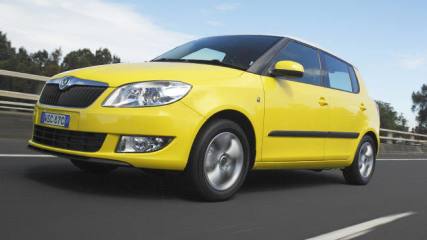Used Skoda Fabia review: 2011-2013
By Graham Smith · 26 Dec 2014
David Scott has done 25,000 trouble free kilometres in his 2012 Fabia 77TSI manual. He rates it the small car bargain of the year and praises its fuel economy, torque, roominess and boot space.Stephen Spinks says his Fabia RS goes well and handles quite good. He's not keen on the way it rolls backwards after a period stopped on a hill as if the hill-hold releases, but the dealer has told him that there is nothing wrong with the gearbox. He also says it uses a little oil.Hugh Rees is enthusiastic about his 2011 Fabia manual, which he says is fun to drive. He says the 1.2-litre engine is really good to drive once the turbo kicks in, the road holding is good, and interior is comfortable and roomy for its size. He gets 5.8L/100 km on average. His only complaint is of a dash rattle.NEWWhen Skoda returned to our market after a long absence it did so as part of the extended Volkswagen family.The company's cars were based on VW models, but carried less challenging price tags than the models they were based upon. The Fabia, for instance, was substantially cheaper than the VW Polo on from which it was derived.It arrived here in 2011 with the 77TSI hatch, which was joined a year later by the hot RS. At the same time the choice of body styles was expanded to include a wagon.While it's based on the Polo it's not obvious from the outside with its pleasantly chiselled lines and bright highlights that set it apart from its corporate cousin.The cabin is functional with comfortable accommodation for four adults. All have adequate head and legroom given the size of the Fabia, and there's a decent amount of boot space.Power for the 77TSI came from a diminutive 1.2-litre four-cylinder engine boosted by a turbocharger. Despite its size it packed plenty of traffic-busting punch, pulling enthusiastically from low revs, while at the same delivering impressive fuel economy. The downside was that it had a thirst for Premium unleaded.At launch there was only a five-speed manual gearbox available, but the options were expanded in 2012 to include VW's seven-speed DSG automatic. The RS hot hatch shared its underpinnings with the Polo GTi.That meant it was powered by the same 1.4-litre 'Twincharger' engine as the VW hottie with its combination of turbocharger and supercharger.With 132kW and 250Nm on tap the RS's performance was sizzling, the combination of supercharger for low-end grunt and turbocharger for punch at higher revs ensuring there was a strong urge all the way through the speed range.VW's seven-speed DSG self-shifting auto-manual gearbox complemented the Twincharger engine in making the most of its torque.On the road the Fabia felt planted and responsive, it was go-kart-like with direct steering and vice-like grip.Standard equipment included air-conditioning, cruise, Bluetooth, eight-speaker sound, MP3, leather-wrapped multifunction steering wheel.NOWBeing based on the VW Polo and sharing its mechanical package the Fabia suffers from the same issues as the little VW.There's the well-documented 'false neutral' issues of the seven-speed DSG gearbox, which was the subject of a voluntary recall by VW.Check any car fitted with the DSG gearbox to make sure a dealer has inspected it for proper function.Oil consumption can be an issue with the 1.4-litre Twincharger engine, particularly in the early stages of life when the engine is running in. In some cases an engine will settle down once it has a few kilometres on it, others take much longer. It's not unusual for the engine to continue to use some oil, as long as it isn't too much it shouldn't be a problem, but if you are concerned about it have a dealer conduct an oil consumption test for you and actually measure it.We know of cases of quite high consumption that have lasted for several thousand kilometres before settling down to an amount that VW considered 'normal'. Ask about the previous owner's experience with oil consumption, it's perhaps best not to take on an oil-burner.With the engine's reputation for consuming oil it's important to check the oil level regularly to ensure it doesn't run short and damage the engine.The 1.2-litre engine doesn't suffer the same issues as the Twincharger.Skoda's build quality is generally of a good standard, so squeaks, creaks and rattles are not normally a problem. Take notice of any you hear, they might indicate a car has been in a crash.Ask to check the service record of your chosen car before handing over your cash, maintenance is vitally important to a long trouble-free motoring life.SMITHY SAYS - 3.5 starsSound and solid, but struggles to match the competition for value.AT A GLANCESPECS:Price new: $18,990 to $21,990Engine: 1.2-litre, turbocharged 4-cylinder, 77kW/175Nm; 1.4-litre turbocharged & supercharged 4-cylinder, 132kW/250NmTransmission: 5-speed manual, 7-speed DSG automatic, FWDEconomy: 5.5L/100 km (1.2), 6.2L/100km (1.4TSCI)Body: 5-door hatch, 5-door wagonVariants: 77TSI, RSSafety: Six airbags, Electronic Stability Control, ABS brakes with EBD and Brake Assist.







